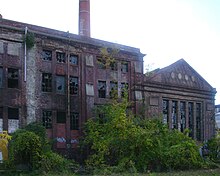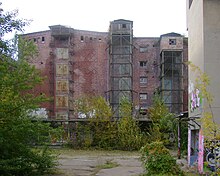Ice cream factory (Berlin-Mitte)

The ice factory of Norddeutsche Eiswerke AG in the former Luisenstadt in the Berlin district of Mitte of the district of the same name is one of the oldest preserved ice cream factories in Germany. The operation was only stopped in 1995. Since then, the site on the Spree at Köpenicker Strasse 40/41 has been empty. Although the factory is a listed building, it is to be demolished.
Buildings and inventory
The 11,000 square meter complex of the Norddeutsche Eiswerke AG by Carl Bolle consists of two courtyards with residential and factory facilities. The ice machine was manufactured in 1914 by Linde AG , for which Rudolf Diesel also worked in Berlin. The boiler and machine house built in 1913/1914 has a clear, neoclassical brick architecture based on the model of early modernism . It is characterized by a temple-like gable , which forms numerous decorative elements made of bricks. The ice factory also includes several cold stores , which are equipped with 15 cm thick cork between the walls for insulation .
On the street side is a residential building, the right part of which was destroyed in World War II. As part of the overall complex, the house that has been preserved is also a listed building and is not to be demolished like the factory, but rather to be renovated. It is rumored that there was a polar bear on the facade. This is supported by the fact that there was a restaurant called Zum Eisbär two doors down .
location
The facility is located in the border area to the districts Friedrichshain and Kreuzberg in the Köpenicker Straße 40/41 next to a fallow land and the ver.di federal headquarters at the Schillingbrücke directly on the banks of the Spree. The property is therefore in the administrative area of the Mediaspree association . The Köpi house project is directly across the street .
The factory is part of a commercial development that stretches like a ribbon on the land between Spree and Köpenicker Straße, on which several wood storage areas and wood markets had already been located in the 18th century.
From 1961 until the political change , the ice cream factory was located on the banks of the river in the border area between East and West Berlin .
history
Artificial ice has been produced in the ice factory since 1896, and since 1914 with an ice machine from Halleschen Maschinenfabrik and iron foundry Stangeneis , which was of great importance for the growing city of Berlin.
Since there were no electric or gas-operated refrigerators in private households, the ice cream was delivered in sticks of around 20 cm × 20 cm and up to 1.50 meters in length to breweries, pubs, households, fruit shops, etc. The milk on the carts of the C. Bolle dairy was cooled with ice sticks, a practice that continued until the late 1970s.
On September 2, 1872, the Norddeutsche Eiswerke AG was founded by Carl Bolle and all of the Bolle ice works became their property. Bolle acquired the property on the Spree on Köpenicker Strasse on the old Berlin timber market in 1893 and began building a small ice cream factory there in 1896 with a residential and office building. Nine years later, the drawings for an ice cream machine for the plant were ready. Under the direction of the building contractor Albert Biebendt, the residential and factory complex for artificial ice production, comprising two courtyards, was built in 1909/1910. During renovation work in 1913/1914, 1916 and 1921/1922, the ice machine that still exists today, as well as three cold stores and the boiler and machine house were built.
The North German Ice Works hit the headlines in 1914 when two bricklayers fell from the scaffolding while building the chimney for the ice factory.
After filling in the Luisenstädtischer channel 1926 of the city garden director should according to the wishes Erwin Barth on Engelbecken one of the temple Taj Mahal ajar Indian garden with palm emerge. The plan was for the warm cooling water from the ice factory to feed an Indian pond. Later, however, the idea of building a public bath at that location arose, which was not implemented because numerous Catholics protested against it. Based on the original idea, only the Indian fountain, which is still in the rose garden today , was built.
In 1945 the right of the factory's two houses was bombed. In the same year, the company's operations were placed under compulsory administration and until 1948 administered in trust by the Association of Berlin Consumer Cooperatives. Around 1949/1950 the Norddeutsche Eiswerke AG was a leasing company for consumption. This became a new legal entity in 1951. On January 1, 1952, the company became publicly owned under the name VEB Kühlhaus Süd-Ost . In the same year, production was reduced from 240 tons per year to 120 tons and in 1962 to 60 tons due to the falling demand for ice rods . The North German ice factories AG was founded in 1977 by Hamburg shifted, dissolved in 1986 and deleted automatically. With the reunification in 1990 the VEB became part of the Berliner Kühlhaus GmbH . The production of ice sticks was stopped in October of the following year.
A fire broke out in 1995 while the planned demolition was being prepared. A side wing of the house became uninhabitable and has been empty since then, burned roofs on the cold stores remained unrepaired for several years.
The Berliner Kühlhaus GmbH gave up operations on Köpenicker Strasse in 1995 and the Treuhand Liegenschaftsgesellschaft (TLG) took over the management of the property.
Against the nationwide resistance of initiatives and associations, the cold stores were demolished by TLG Immobilien GmbH in October 2010.
Current situation
The buildings on the site are heavily exposed to weathering and intensely sprayed with graffiti . On May 28, 2007, a storm caused further damage to the roofs. Shortly afterwards, the damage to the roof of the cold store spread to the inhabited side wing, visible from the outside, but was repaired in August of the same year.
Since October 13, 2007, TLG has again been using a full-day security guard on the ice factory premises. At the end of 2007, TLG gave in and promised that the site would be developed in accordance with the listed buildings. She enforced a demolition permit for the historic cold stores.
In July 2008, TLG sold part of the property with the boiler house, machine house and ice making plant on the Spree.
In April 2010, a fire broke out in the roof of a building after an illegal party took place there. It was deleted within 45 minutes.
In May 2010, TLG began the technical dismantling of the oldest preserved high-temperature storage facilities in Europe to date; the demolition will be completed in early November 2010. Local initiatives, but also nationally organized associations such as the Bund Deutscher Architekten , the Bundesstiftung Baukultur , federal politicians from the CDU , SPD and the Greens had turned to the TLG to stop the demolition. There was an investor who wanted to keep the building, but TLG wants to develop the site itself.
demolition
The architect Ivan Reimann has been planning the demolition of the building and a new building made of glass since 2005 as part of the Mediaspre project despite the monument protection. As planned, only the residential building facing the street and the side wing of the ice cream factory are to remain.
The district office, on the other hand, says it is interested in maintaining the listed ice cream factory. TLG responded to the requests for maintenance with the appeal of an objection . However, this was rejected. At the beginning of 2008, TLG implemented the maintenance requests on some buildings.
In 2007 the architect Gerhard Spangenberg presented a monument-compliant design for the ice cream factory, which would also have had an investor and would have enabled public use. However, TLG rejected the draft.
Initiative to preserve the ice cream factory
The initiative to preserve the ice cream factory protests in cooperation with the citizens' association Mediaspree sink! and, for example, on demonstrations such as the “ Fuckparade ” against the planned demolition and instead calls for an architectural renovation in accordance with monument protection regulations. The alternative construction proposals provide for commercial use of the cold stores and public access to the machine house from the Spreeweg. A restaurant is to be built in the factory courtyard.
Proponents of this solution have already attached banners to the facade of the house facing the street several times , but they only got stuck for a short time. For example, in September 2007 with the label “The ice cream factory can not be visited on the day of the open monument ” to express displeasure about the inaccessibility of the area, or in the following month with the label “No demolition of the ice cream factory” and the motif of a polar bear.
The TLG is accused of neglecting the site and thus contributing to the weathering. However, the condition of the buildings is not yet so bad that demolition is inevitable.
Web links
- Entry in the Berlin State Monument List with further information
- Initiative to preserve the ice cream factory
- Interior and exterior views of the disused ice cream factory Street Art Video
- Impressions documentation “Eisfabrik” April 2010 ( Memento from October 27, 2013 in the Internet Archive ) HD video report
- Major fire in the listed “ice cream factory”. At: tagesspiegel.de , accessed on December 7, 2018
Individual evidence
- ↑ www.buergerverein-luisenstadt.de
- ↑ The house of the Berlin ice cream factory
- ^ Vossische Zeitung , March 3, 1914, evening edition, pp. 5-6
- ↑ Luisenstädtischer Kanal ( Memento from October 3, 2008 in the Internet Archive ) at stadtentwicklung.berlin.de
- ↑ Hot hours in the cold store . ( Memento from July 23, 2013 in the Internet Archive ) In: Berliner Kurier , October 18, 1995
- ↑ The cold store fire brought nasty surprises to neighboring tenants . In: Berliner Zeitung , October 18, 1995
- ↑ " Former ice cream factory burns after party ". In: Berliner Morgenpost , April 9, 2010
- ↑ Visions, projects and objects TLG information brochure (PDF; 6.0 MB)
- ↑ a b c berlin-eisfabrik.de News
- ↑ Transparent for the Open Monument Day
Coordinates: 52 ° 30 ′ 34.5 " N , 13 ° 25 ′ 34" E




